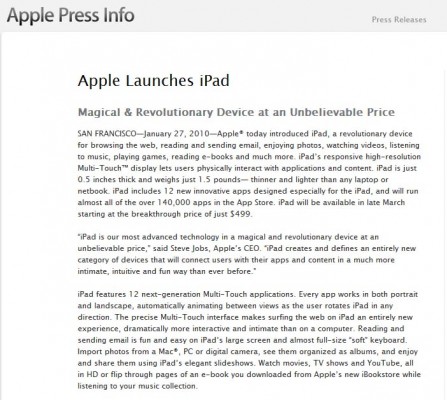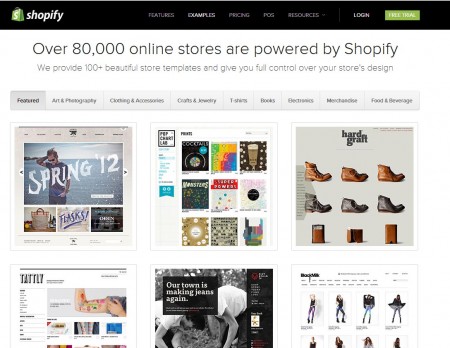
Figure 1. iPad press release
It’s early May 2010. I’m in San Francisco at the Web 2.0 conference. With me are some colleagues and friends from across the island of Ireland, all startups on a mission to learn, network, and for many, to get their hands on the most coveted piece of technology launched only weeks before; the iPad.
Knowing the conference coincided with the launch, my friends pre ordered their model and eagerly waited in line with thousands others, all to be among the very first iPad owners in the world. Some came back with big smiles on their faces, others not so, with demand far out stripping supply, even with a pre order in!
So here we were, at breaks between keynotes and workshops, oohing and aahing at this marvellous tablet, acting like kids waiting for our turn; wishing we’d been as organised. Not for us, the bragging rights, we’d have to wait months for the European launch.

Figure 2. iPad unveiled
iPad hype was everywhere. The excitement was amazing; news bulletins across the world covered the story and interviewed eager customers. The iPad was a hit; a game changer, and Steve Jobs, had yet again, confounded the globe with this sleek piece of savy design and engineering.
Across town, the mood was far less celebratory and the future looked grim for another industry. Unknown to many, San Francisco was once the bookbinding capital of the USA. The remaining companies were a dying breed until something unexpected happened, the arrival of the iPad. So, how could this cutting edge piece of technology help a dying industry? Let’s see!
A young entrepreneur, Patrick Buckley, watched Apple’s product announcement that year. Somewhere between then and launch day an idea struck. If people were prepared to pay $500 for the most coveted cult item of the decade; then surely these same folks would pay for a custom made cover to protect their device. What if the sleeve was disguised as a beautiful book cover and made by professional artisans? Each cover would be unique, bringing with it a quality born from a centuries old tradition.
Buckley decided to use this idea as his entry to a new businesses competition sponsored by Shopify.com and Tim Ferris. The goal was to build the most successful company using Shopify’s eCommerce platform with winner receiving $100,000. And so, Buckley set up first Shopify shop. He found a bookbinder partner (one of only three left in the city) and two prototype were made. In that “quick and dirty” fashion, DODOcase was born alongside the iPad in April 2010.

Figure 3. DShopify eCommerce platform
“We create stylish cases and sleeves designed to disguise your portable technology with classic elegance and functionality”- DODOcase website.
But would this concept work and would customers buy it at a price point necessary to cover the costs? Like any good Lean Startup, DODOcase used the lines of excited iPad buyers to product test their cases and gauge interest, handing out flyers at Apple store across the US, complete with coupon codes.
And sure enough, iPad lovers went crazy for the beauty and the uniqueness of these sleeves, with one reviewer describing them as “the Roles Royce” of iPad covers. Along with this, DODOcase sent samples to celebrities, like Ditta Von Tease, who endorsed the product. Her testimonial, along with rave reviews from bloggers and customers across the globe quickly appeared on the website. One blog post alone generated 1,500 sales.

Figure 4. DODOcase iPad cover
This fledgling business idea, born out of innovation and a desire to preserve an old tradition, had the five key ingredients to make it an instant hit.
• Product: A great product with a great story.
• Positioning: a bespoke, hand crafted product aligned to the smartest, most innovative and most wanted tech product.
• Need: customers wanted to save their fragile tablet from damage and if this protection was as stylish as the iPad itself, then added bonus.
• A cause: the survival of the bookbinding industry in San Francisco, the passing on of centuries old skills. Supporters and customers were encouraged to donate to train more professionals.
• Great branding: The name the message, the logo and the look and feel of the site all gave a consistent message of a must-have premium brand object.
The decision to focus on the product was a master stroke. Instead of spending money the company did not have on mock ups, design and coding, they saved time and resources by concentrating on the core product and marketing it. The decision to use Spotify as their eCommerce partner paid off in spades, with DODOCase making almost $1 million dollars within three months. Here’s how founder Buckley describes it:
“I’m an engineer by training but I’m not a programmer and I wanted to be able to focus on what I was good at and Shopify was great because they let me do that, really. They took all of the high-tech out of business and I was able to focus on the … the low-tech part of it.”
Shopify’s solution was the perfect fit for DODOcase. The seamless design and intuitive shopping cart system, ensured users a great experience. It mirrored the same design and user sensibilities of the product itself. The design and the message were perfectly balanced, all pointing to a product of real value and exclusivity. To this day, DODOcase have continued to use Shopify with great success. At the same time, the PR and marketing from winning the contest also boosted DODOcase’s profile.

Figure 5. DODOcase stamp of excellence
So why is all this important? For me DODOcase points to a new way for creatives and startups to approach building businesses in this new economy, using this new paradigm; marrying craft with technology, delighting customers and adding value.
At first glance, bookbinding and cutting edge technology feels like an oxymoron. But looking at the whole landscape and the world around us, gives great insight. The fate of newspapers and the printed word had been bemoaned for years and the folks at DODOcase were well aware of these trends. It was a gamble but one that was tested and tweaked before spending lots of money or resources. Initial marketing for the company only cost $500, consisting of commissions to the college students from sales.
What DODOcase did back then seems so obvious now. Sitting at every table around me, as I write in a local café, are tablets and smart phones of all descriptions and sizes. But DODOcase got there early. They were bold enough to anticipate the future, to capitalize on emerging trends. Thus, understanding the need, the price customers were willing to pay and creating a buzz around their handmade product, leveraged from the buzz and excitement of the iPad launch.
DODOcase made great use of the web too, capitalizing on reviews, blog posts and mentions. As Buckley describes, “If you can figure out a way to build a business that utilizes the power of the internet as a communications tool to reach customers and you have a really awesome physical product that people want to buy, then you should use one
to leverage the other, in my opinion.”
DODOcase’s branding captured the product style and the product message perfectly, capitpulting a lowly iPad cover into the position of a bespoke must have brand.
As a runaway success, bridging the old and the new, DODOcase’s story was a ray of hope amongst all the negativity about the demise of books and old manufacturing practices. Hence, lots of headlines in newspapers and journals of record further boosting their reputation. Within three months of launch, DODOcase’s bookbinding partner hired14 new employees to fulfill the demand.
And so bookbinding was saved from extinction and a wonderful company continues to grow and prosper. Let’s see how a DODOcase is made, shall we?
DODOcase and the Art of the Book. Handcrafted in America. from DODOcase on Vimeo.
Your comments are much appreciated, what do you think of DODOcase and their approach to building a new business?
Article credits:
Shopify eCommerce store examples here
iPad launch image thanks to cogadget.com
Full iPad 1 Press Release here
Quotes from DODOcase founder Patrick Buckley, from interview on Mixergy.com. Full interview here.
DODOCase image and stamp thanks to www.dodocase.com



















